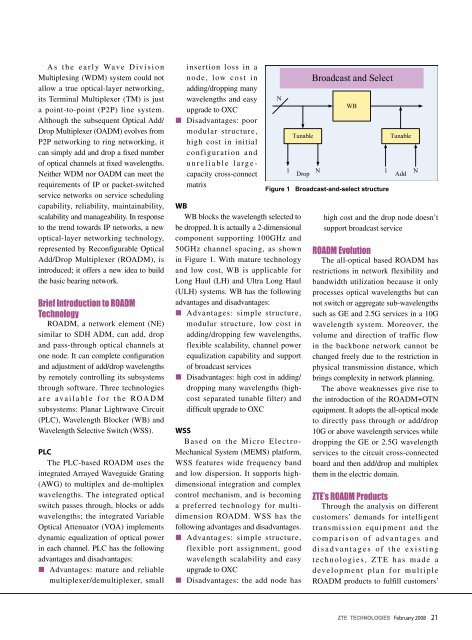PDF download - ZTE
PDF download - ZTE
PDF download - ZTE
Create successful ePaper yourself
Turn your PDF publications into a flip-book with our unique Google optimized e-Paper software.
A s t h e e a r l y Wave D iv i s i o n<br />
Multiplexing (WDM) system could not<br />
allow a true optical-layer networking,<br />
its Terminal Multiplexer (TM) is just<br />
a point-to-point (P2P) line system.<br />
Although the subsequent Optical Add/<br />
Drop Multiplexer (OADM) evolves from<br />
P2P networking to ring networking, it<br />
can simply add and drop a fixed number<br />
of optical channels at fixed wavelengths.<br />
Neither WDM nor OADM can meet the<br />
requirements of IP or packet-switched<br />
service networks on service scheduling<br />
capability, reliability, maintainability,<br />
scalability and manageability. In response<br />
to the trend towards IP networks, a new<br />
optical-layer networking technology,<br />
represented by Reconfigurable Optical<br />
Add/Drop Multiplexer (ROADM), is<br />
introduced; it offers a new idea to build<br />
the basic bearing network.<br />
Brief Introduction to ROADM<br />
Technology<br />
ROADM, a network element (NE)<br />
similar to SDH ADM, can add, drop<br />
and pass-through optical channels at<br />
one node. It can complete configuration<br />
and adjustment of add/drop wavelengths<br />
by remotely controlling its subsystems<br />
through software. Three technologies<br />
a r e ava i l a b l e f o r t h e ROA D M<br />
subsystems: Planar Lightwave Circuit<br />
(PLC), Wavelength Blocker (WB) and<br />
Wavelength Selective Switch (WSS).<br />
PLC<br />
The PLC-based ROADM uses the<br />
integrated Arrayed Waveguide Grating<br />
(AWG) to multiplex and de-multiplex<br />
wavelengths. The integrated optical<br />
switch passes through, blocks or adds<br />
wavelengths; the integrated Variable<br />
Optical Attenuator (VOA) implements<br />
dynamic equalization of optical power<br />
in each channel. PLC has the following<br />
advantages and disadvantages:<br />
■ Advantages: mature and reliable<br />
multiplexer/demultiplexer, small<br />
insertion loss in a<br />
node, low cost in<br />
adding/dropping many<br />
wavelengths and easy<br />
upgrade to OXC<br />
■ Disadvantages: poor<br />
modular structure,<br />
high cost in initial<br />
configuration and<br />
u n r e l i a b l e l a rg e -<br />
capacity cross-connect<br />
matrix<br />
WB<br />
WB blocks the wavelength selected to<br />
be dropped. It is actually a 2-dimensional<br />
component supporting 100GHz and<br />
50GHz channel spacing, as shown<br />
in Figure 1. With mature technology<br />
and low cost, WB is applicable for<br />
Long Haul (LH) and Ultra Long Haul<br />
(ULH) systems. WB has the following<br />
advantages and disadvantages:<br />
■ Advantages: simple structure,<br />
modular structure, low cost in<br />
adding/dropping few wavelengths,<br />
flexible scalability, channel power<br />
equalization capability and support<br />
of broadcast services<br />
■ Disadvantages: high cost in adding/<br />
dropping many wavelengths (highcost<br />
separated tunable filter) and<br />
difficult upgrade to OXC<br />
WSS<br />
Based on the Micro Electro-<br />
Mechanical System (MEMS) platform,<br />
WSS features wide frequency band<br />
and low dispersion. It supports highdimensional<br />
integration and complex<br />
control mechanism, and is becoming<br />
a preferred technology for multidimension<br />
ROADM. WSS has the<br />
following advantages and disadvantages.<br />
■ Advantages: simple structure,<br />
flexible port assignment, good<br />
wavelength scalability and easy<br />
upgrade to OXC<br />
■ Disadvantages: the add node has<br />
Figure 1 Broadcast-and-select structure<br />
high cost and the drop node doesn’t<br />
support broadcast service<br />
ROADM Evolution<br />
The all-optical based ROADM has<br />
restrictions in network flexibility and<br />
bandwidth utilization because it only<br />
processes optical wavelengths but can<br />
not switch or aggregate sub-wavelengths<br />
such as GE and 2.5G services in a 10G<br />
wavelength system. Moreover, the<br />
volume and direction of traffic flow<br />
in the backbone network cannot be<br />
changed freely due to the restriction in<br />
physical transmission distance, which<br />
brings complexity in network planning.<br />
The above weaknesses give rise to<br />
the introduction of the ROADM+OTN<br />
equipment. It adopts the all-optical mode<br />
to directly pass through or add/drop<br />
10G or above wavelength services while<br />
dropping the GE or 2.5G wavelength<br />
services to the circuit cross-connected<br />
board and then add/drop and multiplex<br />
them in the electric domain.<br />
<strong>ZTE</strong>’s ROADM Products<br />
Through the analysis on different<br />
customers’ demands for intelligent<br />
transmission equipment and the<br />
c o m p a r i s o n o f a d va n t a g e s a n d<br />
d i s a d va n t a g e s o f t h e e x i s t i n g<br />
t e c h n o l o g i e s , Z T E h a s m a d e a<br />
d eve l o p m e n t p l a n f o r m u l t i p l e<br />
ROADM products to fulfill customers’<br />
<strong>ZTE</strong> TECHNOLOGIES February 2008<br />
21

















